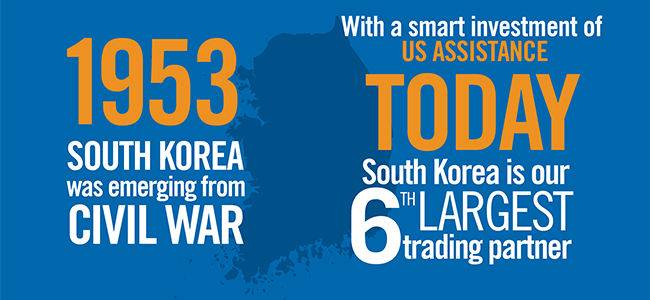
Americans view North Korea as one of our nation’s biggest threats, according to a CNN poll this year, and for understandable reasons. North Korea recently tested its fifth nuclear device, raising tensions and destabilizing peace and security in Asia.
While North Korea’s nuclear and missile tests have increased the urgency to curb their military build-up, they also remind us of the importance of maintaining our long-standing relationships with our allies. Just two hours south of Pyongyang, is the capital of one of our most important allies in the region—South Korea.
Sixty years ago, South Korea was trying to pick up the pieces from the Korean War. The United States subsequently implemented an ambitious package of economic development assistance, partnering with countries that were ravaged by the war. The U.S. invested $35 billion in rebuilding and providing developmental aid over the next several decades.
Thanks to America’s partnership, South Korea went from a recipient of foreign assistance to our sixth largest trading partner. Last year alone, the U.S. exported over $43 billion to South Korea. While it’s important to have a reliable partner in the region in the face of North Korean threats, this transformation also showcases the incredible outcomes our civilian tools, when used effectively, can accomplish.
The successful relationship with South Korea is not the only example. In fact, 12 of the top 15 U.S. trading partners were once recipients of American aid. The most recent success story? Colombia.
Ravaged by narco-terrorism just a little over a decade ago, Colombia was on the verge of collapse. America’s own national security was threatened by Colombian drugs and gangs. Through Plan Colombia, the U.S. provided sustained law enforcement training and economic development programs. This year, Colombia just signed a historic peace deal with the FARC rebel group, and remains a valuable regional security ally and economic partner.
While I’ll leave it to others to determine what a comprehensive plan to dismantle North Korea’s nuclear weapons program should look like, America needs to utilize all its economic and diplomatic tools to meet this global challenge. We must continue engaging with the world and strengthening our leadership role abroad.

And while our civilian tools have helped achieve peace and stability, these international affairs programs are underfunded and undermanned — down 12 percent over the past 6 years. In the face of challenges like the standoff with North Korea, escalating conflicts in Syria and South Sudan, and increasing Russian aggression, our next elected leaders — from Capitol Hill to the Oval Office — must continue to strengthen our investments in development and diplomacy.
Photo: Korean War Destruction, National Archives. Graphic: USGLC.